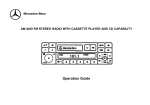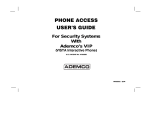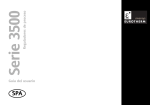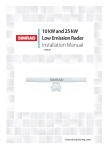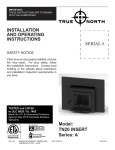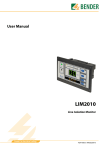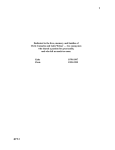Download Becker sound system 1992 1993 1994
Transcript
OPERATION GUIDE FOR BECKER 1432 Overview ________________________________________________________________________________________________ Prepare to enjoy the many pleasures of listening to a superb sound system: the Mercedes-Benz AM and FM stereo radio with cassette player. This Operation Guide is designed to give you both a quick reference of basic functions and features and a detailed description of the system's entire range of operation. To maximize your listening satisfaction, take a few minutes to carefully review all sections of this guide. Note: The following instructions also include the functions of the optional dealer-installed trunk-mounted compact disc changer. Not available in station wagon models. 1432.doc 1 RADIO FUNCTIONS BASIC CONTROLS 1 Power Button DISPLAY PANEL 1 Indicator for Tone Control 2 3 Volume Bar Bass Control/Balance Left Button 4 Treble Control/Balance Right Button Mode Button (Selection of Operating Mode) 2 Stereo Indicator 3 Indicator for Tuner Frequency, Antitheft Code and Balance Setting 4 Indicator for Selected 4 Station Recall Button 5 Wave Band Indicator 5 5 6 Indicator for Tuning Sensitivity Setting TUNING 1 Wave Band and Station Recall Buttons 2 Function Control Button 3 Tuning Sensitivity Button 6 7 1432.doc 2 Seek Tuning Bar Scan Tuning Bar Manual Tuning - Increasing Station Frequency Manual Tuning - Decreasing Station Frequency CASSETTE PLAYER FUNCTIONS BASIC CONTROLS 1 Power Button DISPLAY PANEL 1 Indicator for Tone Control 2 Volume Bar 3 Bass Control/Balance Left Button Treble Control/Balance Right Button Mode Button (Selection of Operating Mode) 2 Indicator for Antitheft Code, Balance Setting and Cassette Functions 3 Indicator for Dolby® B and C Button 4 5 1432.doc 3 CASSETTE OPERATION 1 Reverse Music Search/Fast Rewind Button 2 Forward Music Search/Fast Forward Button 3 4 Track Selection Button, Eject Button (Push and Hold) Tape Selection Button 5 Dolby® B and C Button 6 Cassette Port COMPACT DISC CHANGER FUNCTIONS BASIC CONTROLS 1 Power Button 2 Volume Bar 3 Bass Control/Balance Left Button 4 Treble Control/Balance Right Button 5 Mode Button (Selection of Operating Mode) DISPLAY PANEL 1 Indicator for Tone Control 2 Indicator for CD Function 3 Disc Indicator 4 Track Indicator 5 Random Track Play Indicator CD OPERATION 1 Function Control Button 2 Disc Selection Buttons 3 Forward Music Search/Fast Forward Button 4 Reverse Music Search/Fast Reverse Button 5 Number of Track Display Button 6 7 1432.doc 4 Random Track Play Button Elapsed Playing Time Button BASIC CONTROLS Power: The sound system will operate with the car's ignition switch in either the PWR on or off position. To operate the radio or the optional CD changer, simply push the power button located at the lower left corner of the radio faceplate. Pushing the power button again will turn the radio off. A tape cassette can be played without using the power button by simply inserting the tape into the cassette port. As soon as the cassette is drawn into position, it will begin to play. Mode: Pushing this button repeatedly will cause the radio to cycle through each of its MODE operating modes: tuner, cassette player and CD player (if so equipped). 1432.doc Volume: Sound level is adjusted by means of the volume bar located on the left side of the radio faceplate. Press VOLUME upward to increase volume or downward to decrease volume. Speed-Dependent Volume Adjustment: A special function adjusts the volume of sound a preset amount according to vehicle speed. Thus, increased wind and road noise are compensated for as the vehicle is driven faster. When vehicle speed and thus ambient sound level drop, the volume is automatically lowered a preset amount. Tone: Two tone buttons, identified by musical notes, are located above the volume bar. The left button controls bass, and the right controls treble. A bar graph at the left of the 5 radio display indicates relative bass and treble settings. To bring both bass and treble tones to their midrange settings, press both buttons simultaneously. To bring either bass or treble tone to maximum level, press and hold the respective button. If the button is d p released and then pressed again, the tone level will move toward its minimum level. To reverse adjustment direction, the maximum level must be reached first. The system is equipped with a memory function that will store the adjustment tone levels of AM, FM, cassette and optional CD modes separately. Balance: Left-to-right stereo balance is adjusted using the same buttons that control bass and treble levels. First press the function control button, which is on the right side of the display and marked with a star "*". To shift sound balance to the left speakers, press the bass control button. To shift balance to the right speakers, press the treble control button. Balance can be set to the mid-position by pressing both buttons simultaneously. A visual indication of the * d p balance setting is provided on the display when the balance feature is activated. Fader: A fader control is provided on models equipped with both front and rear speakers. Located on the lower console near the gear selector, this thumbwheel control can be adjusted to suit your preference. Dialing the thumbwheel forward will increase output of the front speakers while reducing that of the rear. Conversely, dialing the thumbwheel backward will increase output of the rear speakers, while reducing that of the front. Positioning the thumbwheel in its center detent will equalize sound output. 1432.doc Antenna: The antenna extends automatically whenever the radio is switched on and retracts whenever the radio or the vehicle's ignition is switched off. Power-Off Delay: When you are listening to the sound system and turn off the ignition key, the sound system will continue playing for three seconds. This allows you sufficient time to turn the ignition key to the accessory position without interrupting the function of the radio, the cassette player or the optional CD changer. Battery Conservation: It is possible to operate the radio when the ignition is off for up to an hour. After one hour, the radio will automatically shut itself off to conserve battery power. If continued listening is desired, simply press the power button again. 6 Radio Operation Radio Operation The radio is capable of receiving monaural AM broadcasts and monaural and stereo FM broadcasts. A stereo indicator will appear on the radio display whenever an FM stereo signal is received. To select the wave band you wish to hear, simply press any one of the numbered station recall buttons located along the top of the radio faceplate-1 through 6 for FM, 7 through 0 for AM. To tune to a specific station, use any of the following methods: Seek and Scan Tuning: The seek bar, located on the right side of the radio faceplate, can be used to tune SEEK SCAN in broadcast frequencies within AM or FM wave bands. Pressing the bar up will cause the radio to lock onto stations tracked in ascending frequencies; pressing it down will track stations in descending order. 1432.doc The scan bar, located directly to the right of the seek bar, allows sampling of radio stations within a wave band for approimately five seconds each. If no action is taken during the five-second period, the radio will tune to the next station. Pressing either the seek bar or the scan bar a second time will cause the radio to stay tuned to the station being sampled. Sensitivity Control: This feature enables you to choose two tuning sensitivity levels by pressing the sensitivity control button located on the far right side of the radio faceplate. The level you select will be indicated by an L (local) or a D (distant) appearing on the right side of the radio display. In the local mode, the radio will seek and scan only the strongest signals. In the distant mode, it will seek and scan less powerful signals as well. The 7 sensitivity level is automatically increased after the entire wave band has been sampled without finding a station. Direct Frequency Tuning: To tune directly to a specific frequency, switch to your desired wave bandAM or FM-as described, then press the function control button, which is AM or FM * identified by a star "*" and located just to the right of the radio display. The display will go blank. Next, press the numbered buttons corresponding to the digits of your desired station. For example, to select the frequency 98.5, you would first press the function control button to clear the display. Then you would press button numbers 9, 8 and 5 in consecutive order. The display would then read 98.5, and the station at that frequency would begin playing. The driver, of course, should not v ^ use the direct frequency method when the vehicle is in motion. Continue holding the button until this station is deleted from memory and the frequency of your newly selected station appears on the display. The new frequency will be stored in memory. Manual Tuning: To manually tune through each possible radio broadcast frequency in ascending order, press the right manual tuning button. Each possible frequency number will appear in the display as you reach it. To manually tune through radio stations in descending order, press the left manual tuning button. If a tape has already been loaded but a different mode (tuner or CD) has been subsequently selected, press the mode button until cassette play resumes. Push-Button Memory Tuning: The most convenient method of tuning is to store your favorite stations in the radio's memory. Six FM stations and four AM stations may be stored by using the numbered station recall buttons located along the top of the radio faceplate. CR Tape Switch: This feature allows you to select the proper equalization setting for playing chromium dioxide (CrO2) or "metal" cassette tapes. The radio display will show CR when this option has been selected. First, using either the seek, scan, or direct frequency tuning methods, tune in the station you wish to store. Next, push and hold the numbered station recall button you wish to use. The radio will display the station currently stored at that number. 1432.doc CASSETTE OPERATION To play a cassette, insert it into the cassette port with its side one or A up and the exposed tape side facing the port. The cassette will be drawn automatically into the deck. At the conclusion of the first side's play, the auto-reverse mechanism will automatically begin playing the other side of the tape. 8 Eject: To remove a cassette, push and hold the track selection/eject button until the tape automatically 1-2 disengages and can then be retrieved from the cassette port. Ejecting a cassette switches the system to radio operation. Forward Music Search/Fast Forward: A cassette tape can be automatically advanced to the next selection by pressing the forward music search button once. >>I The radio's display will show MSF and the current track to indicate that music search has been activated. To fast-forward the tape to the end of the side, press the forward music search button twice. The radio's display will show FF and the current track to indicate the fast-forward function has been activated. Reverse Music Search/Rewind: A cassette tape selection can be repeated by pressing the reverse music search button once. The radio's display will show MSR and the current track to indicate that music search has been activated. 1432.doc Push the button twice to completely rewind the tape. Once engaged, it will lock into position until the tape is fully rewound or until another tape function is activated. I<<R The radio's display will show REW and the current track to indicate that the rewind function has been activated. Track Selection: Once a cassette has been engaged, the track selection button can be used to switch to the tape's other side without having to remove and flip the cassette. The radio's display will always indicate the current track being played. Dolby® B and Dolby® C Noise Reduction: This function, which is activated by pressing the B> <C Dolby noise reduction button, reduces background hiss while playing a cassette that was recorded using the Dolby® B or Dolby® C noise reduction system. Most prerecorded cassettes indicate the type of noise reduction that was used during recording (if any). The radio's display will indicate the noise reduction system selected. 9 Compact Disc Operation If the optional dealer-installed CD changer is connected to your system, it can be operated via the same keys that control the radio and cassette player. During this procedure, the display panel will read LOAD M if in CD mode. Once the CD changer cycles through the discs in the magazine, the first CD will play. The same instructions that govern volume, tone and balance in the radio and cassette modes apply to the CD mode as well. However, some system functions and procedures are exclusive to the CD mode. Ejecting the CD Magazine: To eject the magazine from the CD changer, press the CD port door lock to open the magazine port door. Press the magazine eject button inside the port door and the magazine will automatically slide halfway out of the magazine port; remove the magazine manually and close the port door. Loading the CD Magazine and CD Changer: The CD changer is inside the car's trunk. Its magazine will accept up to ten discs. Insert the discs into the magazine compartments with the label surface facing up. When the magazine is loaded, place it into the CD changer port. An arrow on the top surface of the magazine indicates which end should be inserted first. When you feel the magazine lock snugly into position in the port, close the port door. 1432.doc To Play CDs: First, turn on the radio. Press the mode button once or twice, depending on the operating mode set before, until CD appears on the display. If the CD magazine has not been inserted into the CD changer or if there are no discs in the CD magazine, the display will indicate CD-M-E, meaning CD Magazine Empty. 10 The radio's station recall buttons, numbered 1FM through 0AM, function as CD disc-select buttons as well. To play the disc in the CD magazine's fourth compartment, for example, press button 4FM. Load 4 appears on the display as the disc is placed into position; the display changes to CD 14 once the disc begins to play. To interrupt one disc and choose another press the appropriate discselector button for the disc desired. The display will read LOAD and the number of the desired disc until the newly selected disc begins playing. Should two horizontal lines appear on the right side of the display, this indicates that an empty compartment in the CD magazine was selected. Forward Music Search/Fast Forward: To move from one track to the next on the same CD, simply press the forward music search button. The current track will fade out, and a moment later the CD's next selection will begin. Similarly, to move ahead three selections, quickly press the key three times. To move consecutively through several tracks, press and hold the forward music search button; in this way, you can advance as far as the 1432.doc beginning of the last track on the disc. To fast-forward through a given track, press the function control button "*" and then the forward music search button. To help gauge your progress through a track, the disc's elapsed playing time will be indicated on the display. Reverse Music Search/Fast Reverse: To repeat an earlier track on the disc you are listening to, press the reverse music search button. Press it once to go back to the beginning of the selection currently playing, twice to return to the beginning of the previous selection, and so forth. Press this button for a sustained period, and you will move consecutively through several selections, all the way to the beginning of the disc, if you choose. To fast-reverse through a given selection, press the function control button "*" followed by the reverse music search button. To help monitor 11 how far you have back-tracked through the selection, the display will indicate the disc's elapsed playing time. Random Track Play: To play the tracks on a CD in nonconsecutive order, press the Dolby® B/C button once. In this mode, the track number indicated on the display will be followed by an R to show that selections are being randomly chosen. To cancel this command and return to sequential playing of CD selections as they are ordered on the disc, press the Dolby® B/C button once more. Display of Tracks and Playing Time: To determine the number of tracks on the selected disc, press the function control button "*", and then the tape selection button CR. The display will indicate the total number of selections for eight seconds. Similarly, to determine how long a disc has been playing, press the function control button "*", and then the mode button. A three- or fourdigit number will appear in the display - the first one or two indicating minutes, the second two indicating seconds. A display readout of 3417 means the disc has been playing for thirty-four minutes and seventeen seconds. Maintenance Notes for CD System: Extreme temperatures will affect the performance of the CD system. However, optimum performance will occur between 32 and 140 degrees Fahrenheit. Dampness on the disc surface can be caused by changing temperatures and may affect disc performance, inhibiting the system's laser from focusing and making it impossible 1432.doc for it to read the contents of a disc. As soon as relative humidity has decreased, this situation will correct itself, usually within one or two hours. Although compact discs are specially coated for durability, they should still be handled carefully. Handle discs only by the edges and avoid fingerprints, dust, scratches, and dampness on both surfaces. Do not label the discs or affix paper or tape to them. After removing a disc from the magazine, store it in its original case. If needed, clean the disc with a CD cleaning cloth, wiping radially from the center of the disc to the edge. Do not use solvents such as benzene, thinner, or commercially available cleaners intended for analog discs. Mistracking or skipping due to road shock is unavoidable but will not damage the unit or discs. Caution: This CD player contains a Class 1 laser unit. If the cover is opened or damaged, there is 12 danger from invisible laser radiation. Do not remove the cover. There are no parts that can be repaired by the user. Only qualified service technicians should attempt internal maintenance or repairs. High Performance Sound Standard on all S-Class and SL models, as well as the 300E, 300E 4MATICTM and 300 CE*, is a special High Performance Sound System, which has been specifically engineered and equalized for the interiors of these particular models. 1432.doc Developing vibrant stereo power by means of separate audio power amplifiers, the system plays through ten high-quality speakers in the SClass and 300 Class models: two low-frequency, two mid-frequency, four high-frequency and two midhigh-frequency units. The SL sound 13 system has six speakers: two lowfrequency, two mid-frequency, and two high-frequency units. * Optionally available on the 300 D 2.5 Turbo and the 300 E 2.6. Antitheft System The Mercedes-Benz AM and FM stereo radio with cassette player and CD compatibility is fitted with a built-in system designed to help render it inoperative in case of theft. If the radio or battery is disconnected, the radio will be automatically disabled. To indicate this state, the word CODE will appear on the radio's display. To render the radio operable again, the correct four-digit code must be entered into the radio via its numbered station recall buttons. A code is preassigned to each radio and supplied to the owner on two walletsized cards. Recoding Sequence: To recode a radio, follow this procedure: 1. Turn ignition key to lock position one. 2. Turn on the radio. The word CODE appears on the display. 3. Enter the first digit of the radio's antitheft code as it appears on the code card. The word CODE will disappear and the first number that you have entered will be displayed. 1432.doc 4. Enter the rest of the antitheft code. Each number will be displayed when it is keyed in. 5. When all four antitheft code numbers have been correctly entered, radio operation will resume. The station stored at push-button 1FM will play. Incorrect Code: If an incorrect antitheft code digit is entered, continue to enter numbers until four are displayed. The word CODE will appear again. The system allows two more recoding attempts. After the third incorrect attempt, the word WAIT is displayed. A period of 15 minutes must pass and the word CODE must again be displayed before recoding can be successful. The radio must be left ON during this period. This measure is meant to prevent a thief from recoding the radio by randomly entering numbers. If the correct antitheft code has not been entered after three separate attempts-and therefore after two 15minute WAIT intervals-the radio will lock for 24 hours to prevent any 14 further recoding attempts. The radio must be left ON during this period in order for it to reenter the CODE mode. Code cards should not be stored in the glove compartment. During vehicle service at an authorized Mercedes-Benz dealer, we recommend that you leave one card with your service advisor. Thus, if the battery is disconnected, the service advisor can recode the radio before the car is returned to you. If the car is equipped with a Mercedes-Benz antitheft alarm system, the alarm will sound should the radio be removed from the console while the alarm system is armed. If you have difficulty reprogramming the radio or if the reprogramming function fails to operate, please contact your authorized Mercedes-Benz dealer.














